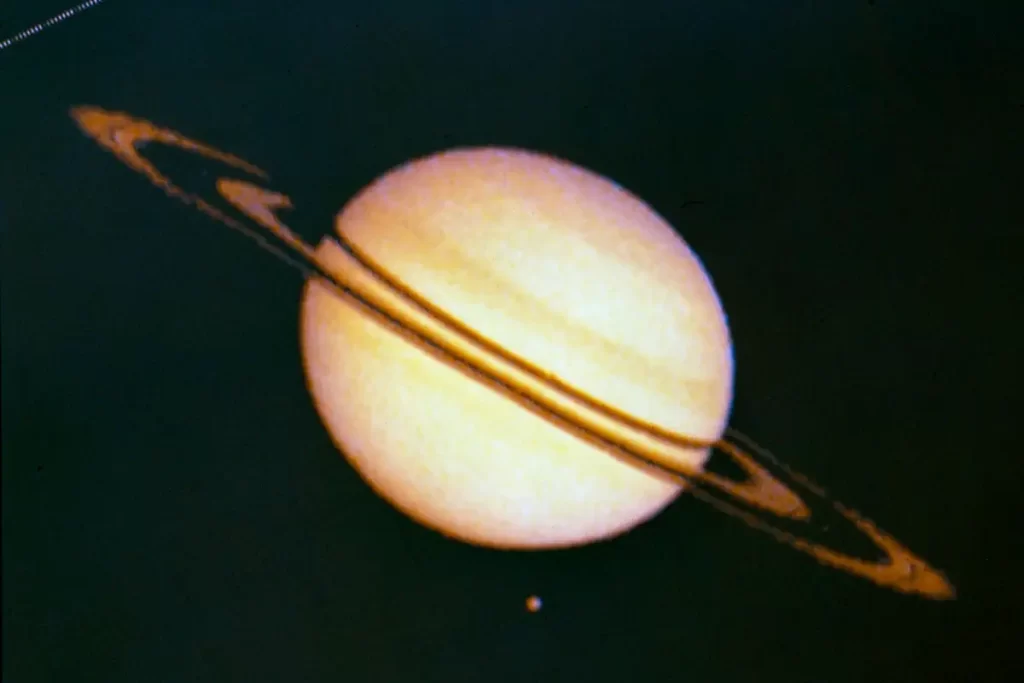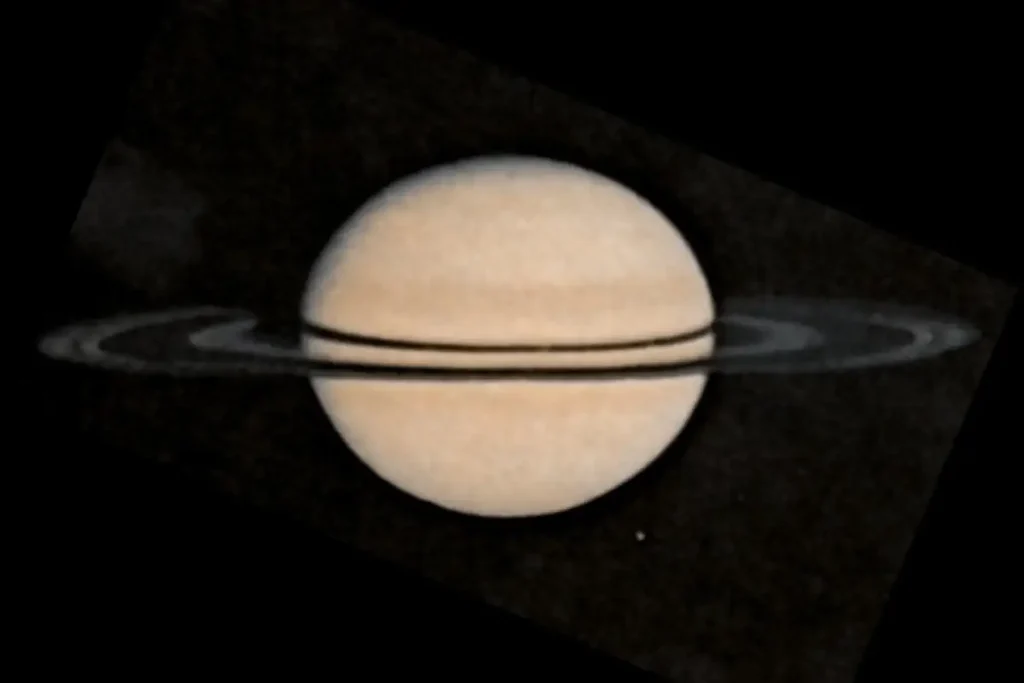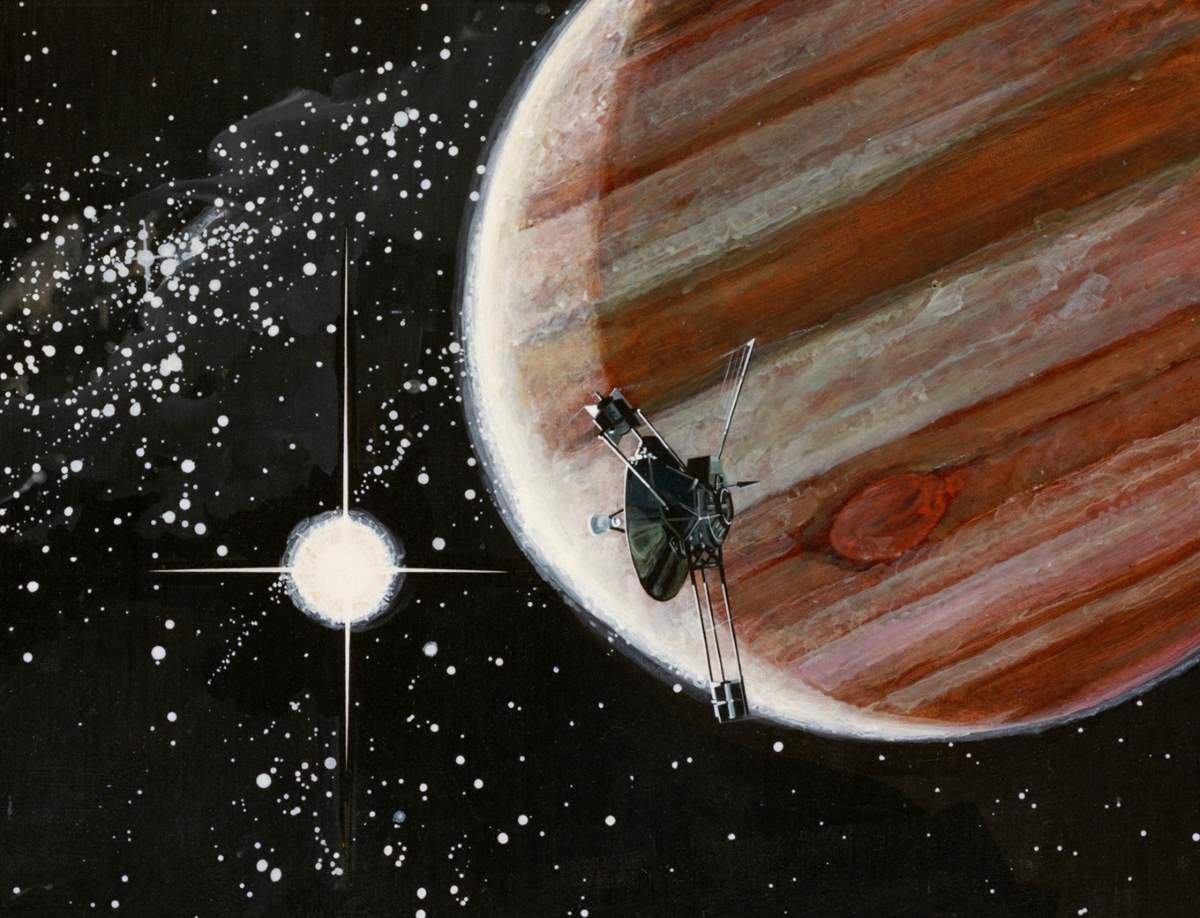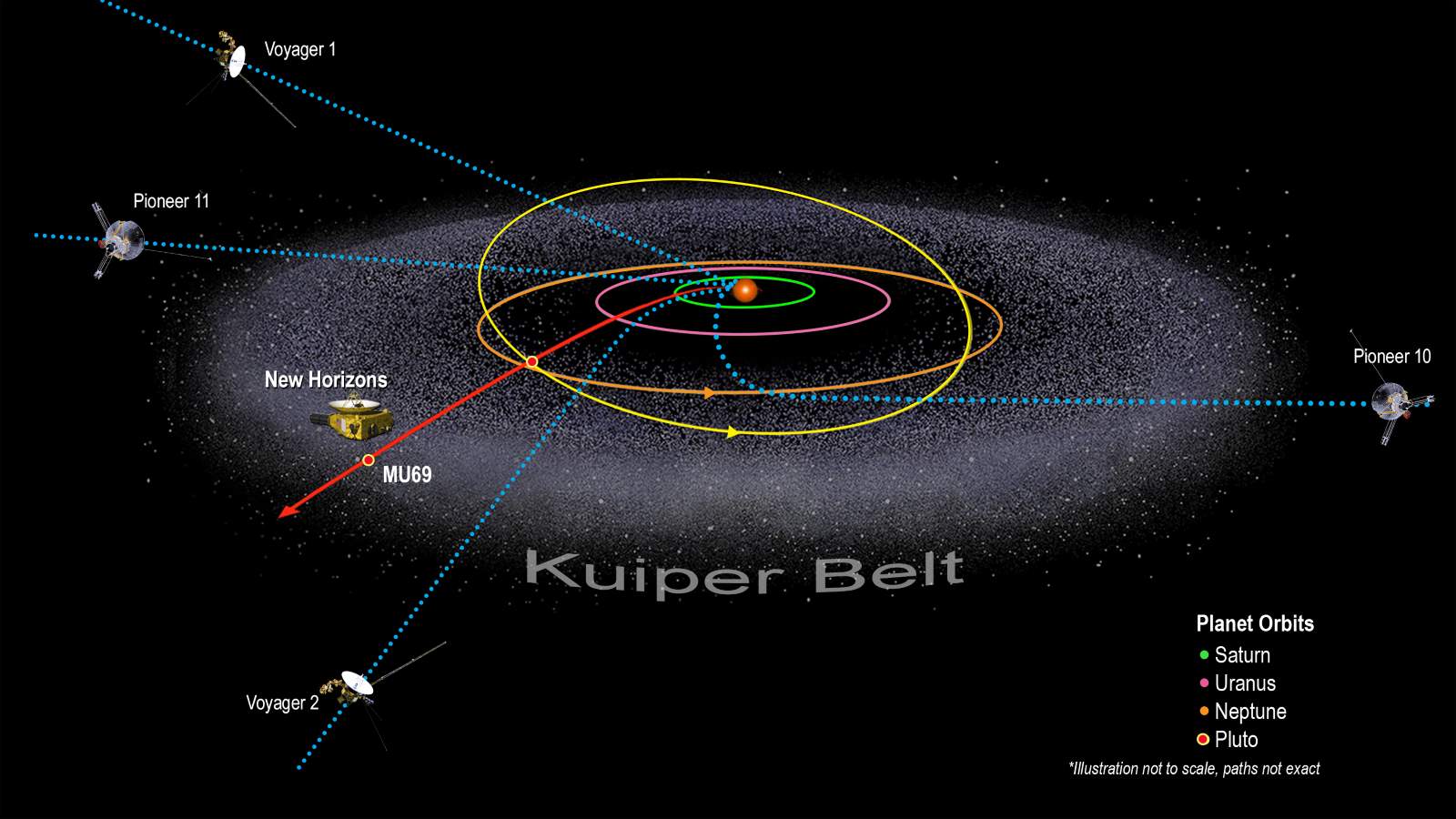On September 1, 1979, NASA’s Pioneer 11 spacecraft performed the first Saturn flyby in the history of space exploration, at a distance of 21,000 km (13,000 miles) from Saturn’s cloud tops.
Today’s (September 1) story of what happened this day in Science, Technology, Astronomy, and Space Exploration history.
Pioneer 11’s historic first Saturn flyby
Pioneer 11 was launched from Cape Canaveral on April 5, 1973, on top of an Atlas-Centaur rocket. It was actually intended as a backup to its twin, Pioneer 10. By the time Pioneer 11 launched, Pioneer 10 (launched on March 2, 1972) had already safely traversed the asteroid belt and was on its way to the very first encounter with Jupiter in December 1973.

After Pioneer 10 successfully completed its observations of Jupiter, in May 1974 mission planners retargeted Pioneer 11 to use the giant planet’s gravity to slingshot the spacecraft to encounter Saturn.
Pioneer 11 completed its crossing of the asteroid belt on April 14, 1974, and encountered Jupiter on December 2, taking the most detailed images of the Great Red Spot and mapping Jupiter’s polar regions. The spacecraft’s closest approach to Jupiter was at 42,828 km (26,612 miles).
Course corrections in May 1976 and July 1978 refined the spacecraft’s trajectory toward Saturn.
In late July 1979, Pioneer 11 began its observations of Saturn. By that time, Voyager 1 and Voyager 2 had been launched, had completed their fly-bys of Jupiter, and were on their way to Saturn as well.
Mission managers at NASA had to choose where to target Pioneer 11’s flyby of Saturn to provide maximum support to the twin Voyager spacecraft.
Options included a more scientifically interesting but riskier passage through Saturn’s inner rings or a less interesting pass through the outer rings but which would be a pathfinder for Voyager 2 that would have to take that same path to ensure the proper gravity assist to send it on to Uranus and ultimately to Neptune.
After much deliberation, managers decided it was more important to ensure that Voyager 2 completed the planned grand tour of the outer planets of our solar system.

On September 1, 1979, Pioneer 11 performed the first Saturn flyby in the history of space exploration: it passed within 21,000 kilometers (13,000) miles of Saturn’s cloud tops at a velocity of 114,263 km/h (71,000 mph).
During the encounter, Pioneer 11 sent back data on the planet, its rings, and its satellites, including 440 images. Based on the data, scientists learned that Saturn’s atmosphere consists mostly of liquid hydrogen and confirmed that the planet had a magnetic field.
Images of Saturn’s moon Titan revealed an orange cloud-shrouded globe, with a global temperature of minus 315o F. Pioneer 11 discovered two new moons and one new ring orbiting Saturn. The spacecraft completed its study of the ringed planet on October 5, 1979.

Details of the first Saturn flyby in the history of space exploration
Pioneer 11 was actually not designed to fly to Saturn, that mission arose only after a successful Jupiter flyby in 1974, calling at first for Pioneer to fly through Saturn’s rings on what the Washington Post called a “kamikaze mission.” The most dangerous moment of the 6.5-year 2-million-mile journey would be crossing September 1 through belts of unknown material beyond the ring systems around Saturn that had been visible from Earth, during which Pioneer would risk a potentially fatal collision.
Because of intense radiation (solar-particle interference was degrading the quality of Pioneer images), mission controllers at ARC had reduced the data transmission rate by half. Solar storms had occurred late in July and in midAugust, and high-energy particles from the second storm had reached Saturn at the same time as slower particles from the first storm. Reducing the transmission rate would diminish the effects of interference and also the quality of the images.
Pioneer would enter the dangerous area outside the visible ring system at 10:44 a.m. EDT, but scientists would not know for 86 minutes whether it had survived (the time the signals needed to reach Earth). No one
knew the composition of the 2-minute-wide third ring; if it consisted of boulders, Pioneer could probably get past it safely, but a ring of dust particles could riddle the fast-moving craft and end its career. Project scientist Dr. John Wolfe said chances for survival were 50%
At the time, the photos already transmitted by Pioneer 11 were better than any yet taken from Earth-based telescopes.

The Washington Post reported on September 1 that solar storms had increased the noise level in space to 10 times normal. In the early afternoon, Pioneer 11 had flown into a detectable magnetosphere, showing that Saturn was surrounded by a strong and sizable magnetic field estimated at 700 to 1,000 times the size of Earth’s but roughly equivalent in strength.
Pioneer 11 successfully performs the first Saturn flyby ever
On September 2, The New York Times reported that, as of 12:31 p.m. EDT, Pioneer 11 had survived a hail of fine particles to get within 13,000 miles (about 21,000 km) of Saturn for a 4-hour first encounter, the first Saturn flyby ever.
During the approach, scientists were keeping watch on the plane of the visible rings through which Pioneer was descending: Dr. James Van Allen of the University of Iowa was the first to note Pioneer 11’s approach to “dangerous ring debris” in its path. However, the 10:30 a.m. crossing at a speed of 48,000 mph (77,200 km/h) had taken only a second, though ARC had to wait until 2:02 p.m. to learn what had happened; when the radio signals continued past that moment without interruption, “a cheer went up.”
LaRC’s (NASA Langley Research Center) Donald H. Humes said that Pioneer 11 might have had a close call, as the micrometeoroid detector had registered two impacts during the crossing: this was the limit of the instrument’s counting ability, and more impacts might actually have occurred. The impacts apparently caused no damage.
The sharp rise in radiation encountered by Pioneer 11 before it flew under the rings had fallen as abruptly as it rose, and by the time Pioneer 11 was under the rings (closer to the planet) the radiation reading had disappeared completely.
Dr. John Simpson of the University of Chicago said the rings were big enough to “scour out” nearly all the radiation trapped by the planet’s magnetic field. The New York Times quoted Dr. Van Allen as saying that the radiation count while Pioneer 11 flew under the rings was even lower than while the spacecraft was sitting on its launching pad at Cape Canaveral, 6.5 years ago. Saturn’s radiation, although it would be lethal to an unprotected human, posed no hazard to spacecraft, Van Allen added.
After the flyby
After its close approach, the first Saturn flyby in the history of space exploration, Pioneer swung behind the planet, out of radio contact for 78 minutes, during which its onboard instruments recorded data for later transmission. Upon reemerging, the spacecraft had to cross the ring plane again on its outward journey; the outbound crossing came at 2:32 p.m., and controllers again had to wait for an indication that the spacecraft was safe.
At 3:55 p.m. the signals affirmed that Pioneer 11 had survived another crossing. This was the last predicted hazard for the spacecraft, which would continue past Saturn to the outer edge of Earth’s solar system and enter interstellar space, by which time its radio would no longer be audible.
The safe passage meant that Pioneer 11 could spend September 2 and 3 photographing Titan and measuring Saturn’s rings from the dark side of the planet; also, that the two Voyager spacecraft following Pioneer could approach without fear of damage. In its two-hour passage, besides recording impacts, Pioneer 11 had photographed a new ring previously undetected by Earth telescopes, called the F ring: scientists already knew of four rings called A through D (in order of discovery, not location), three of them bright enough to be seen from Earth telescopes, and a fifth (or E) ring had been suspected close to the A ring although Pioneer 11 did not report it.
Pioneer 11 had also tracked what might be a new Saturn moon orbiting about 70,000 miles (112,600 km) out; some thought it might be a known moon, Janus, but it was in a position indicating that it was an entirely new satellite that would bring Saturn’s count to 11, one short of Jupiter’s 12 (at the time). This object is now known as Epimetheus, the eleventh moon of Saturn.
Pioneer 11 photos of Saturn showed dark blue and green stripes across it just below the north pole; the colors, not so vivid from Earth, probably came from sunlight scattering in upper-atmosphere clouds. Jet streams like those seen on Jupiter appeared to whirl around Saturn at speeds of 300 mph (483 km/h).
Pioneer images could give a better idea of the dimensions and composition of the rings when compared with Earth-based photographs. In the six years it had taken to reach Saturn, Pioneer 11 had reported a space-particle strike only once every two months or so, LaRC’s Humes recalled. Once past Saturn, Pioneer was to photograph Titan from about 221,000 miles (356,000 km), record its temperature and atmospheric methane, and try to detect “life chemicals”; as no life was evident on Venus or Mars, this might be the last chance to find extraterrestrial biology in the solar system.
Titan
The first images of Titan had shown a fuzzy ball of light indicating a stratospheric layer of orange smog with blue streaks that might denote an atmosphere beneath the smog and clouds. The closest approach at 2:04 p.m. on September 2 was 220,000 miles (about 350,000 km), and Pioneer 11 had taken the first pictures at 260,000 miles (418,000 km). The pictures would be enhanced by computers before scientists could make detailed analyses.

On September 3, Pioneer was already more than a million miles from Saturn, relaying no ill effects from the planet’s rings or radiation belts.
Early on the morning of September 2, NASA reported the loss of about two hours of Titan data from Pioneer transmissions to the Madrid station; Ames Research Center (ARC) controllers did not know whether the loss occurred between spacecraft and station or between Spain and the control center about 40 miles south of San Francisco.
The loss between spacecraft and station would be irretrievable: Pioneer 11 had only one opportunity for Titan observations after its close approach. It was not sending images at the time, but about 15 minutes of a CalTech infrared sensor’s readings on Titan temperature were lost.
The cause might have been electrical storms in space or on Earth, or passage of the signals close to the surface of the Sun on their way to the Earth, any of which would make it difficult or impossible for the Madrid station to lock on to the signals.
Project manager Charles Hall reported on September 4 that the Titan data loss previously attributed to radiation disturbances was now thought to result from radiofrequency interference by a Soviet satellite. Both Pioneer 11 and three USSR satellites had been operating on a frequency reserved for scientific use.
The Soviet Union had twice agreed to shut down during the Saturn encounter, and Hall said NASA had “no doubt the Soviets would have acted” if they had been asked; “we did not request them to turn off their satellite on Monday,” U.S. scientists did not realize at first that signals from a recently launched Soviet satellite might interfere with reception of Pioneer data, being “between 100 and 1,000 times stronger than the signals we were receiving from our
spacecraft.”
Aerospace Daily said on September 6 that the three Soviet satellites that had stopped transmitting September 1-2 for the benefit of Pioneer’s Saturn flyby were early-warning satellites designed to detect U.S. ballistic missile attacks on the Soviet Union.
Cosmos 1024, 1109, and 1124 had suspended transmissions September 1 and 2 at NASA’s request; however, no request was made regarding September 3 (September 2 in the U.S.), and Cosmos 1124 had operated as usual. Western analysts questioned, Aerospace Daily noted, “whether the U.S. would suspend communications with any of is early-warning satellites if the Soviets made such a request” during a planetary mission.
Pioneer project officials told a September 6 news briefing that the loss of Titan data was not the fault of the Soviet satellite, which was broadcasting before but not during the lost transmission. Poor data resulted from the combination of solar storms and poor transmission from Madrid. Some data had in fact reached ARC (Ames Research Center) but was so “noisy” as to be useless.
NASA ends operations
On February 25, 1990, Pioneer 11 became the 4th human-made object to pass beyond the orbit of the planets, after Pioneer 10 (June 13, 1983), Voyager 1, and Voyager 2 (August 5, 1979).
By 1995, Pioneer 11 could no longer power any of its detectors, so the decision was made to shut it down.
On September 29, 1995, NASA’s Ames Research Center, responsible for managing the project, issued a press release that began, “After nearly 22 years of exploration out to the farthest reaches of the Solar System, one of the most durable and productive space missions in history will come to a close.”
It indicated NASA would use its Deep Space Network antennas to listen “once or twice a month” for the spacecraft’s signal, until “sometime in late 1996”.
One day after that press release, NASA engineers terminated routine contact with Pioneer 11 on September 30, 1995, when the spacecraft was 6.5 billion km (approximately 43.4 AU, see notes 1) from Earth, but continued to make contact for about 2 hours every 2 to 4 weeks.
On November 24, 1995, scientists received a few minutes of good engineering data but then lost final contact once Earth moved out of view of the spacecraft’s antenna. Pioneer 11 remains silent since then.
Current status of Pioneer 11
As of August 2022, Pioneer 11 is estimated to be 109.153 AU (1.63291×1010 km; 1.01464×1010 mi) from the Earth and 109.81 AU (1.6427×1010 km; 1.0207×1010 mi) from the Sun; and traveling at 11.182 kilometers per second (40,260 km/h; 25,010 mph, relative to the Sun) and traveling outward at about 2.36 AU per year.
Pioneer 11 is now headed toward the constellation of Aquila, northwest of the constellation of Sagittarius. Barring an incident, it will pass near one of the stars in the constellation in about 4 million years.
Notes
- An Astronomical Unit (AU) is the average distance between Earth and the Sun, which is about 93 million miles or 150 million kilometers. Astronomical units are usually used to measure distances within our Solar System.
Sources
- “In 1973 Pioneer 11 was launched, went on to be the first human-made object to fly past Saturn” on the NASA website
- Pioneer 11 on the NASA Solar System Exploration website
- “Pioneer 11 Image of Saturn and Its Moon Titan” on the NASA website
- “Pioneer 11 at Saturn” on the NASA website
- “Pioneer 11 First to Explore Saturn” on the NASA website
- Pioneer 11 on Wikipedia
- Astronautics and Aeronautics, 1979-1984 (Pdf)
- Moon Landings: All-Time List [1966-2025] - February 2, 2025
- What Is Max-Q and Why Is It Important During Rocket Launches? - January 16, 2025
- Top 10 Tallest Rockets Ever Launched [2025 Update] - January 16, 2025


